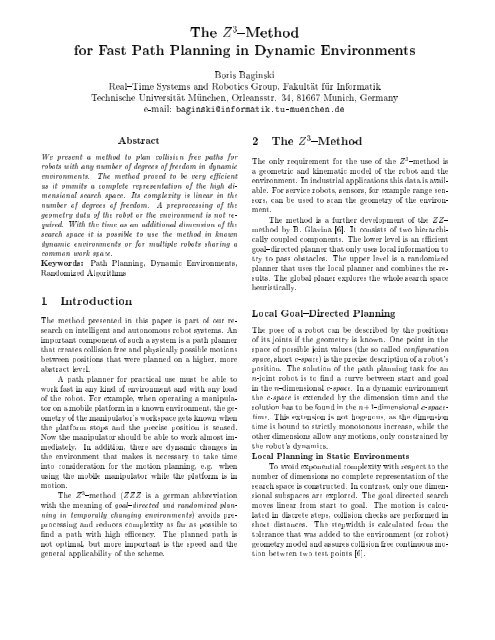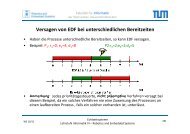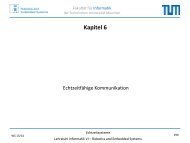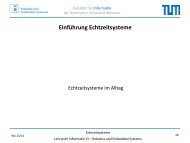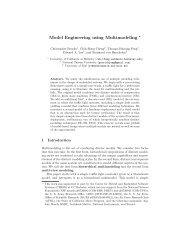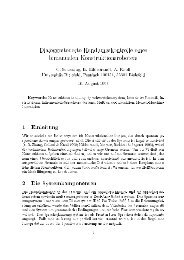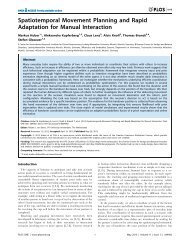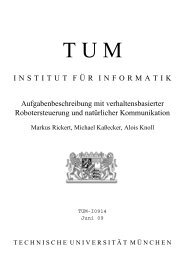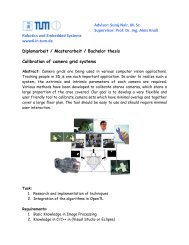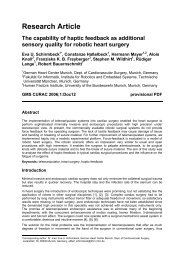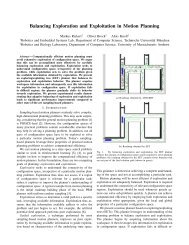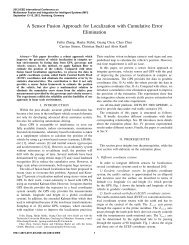The Z3{Method for Fast Path Planning in Dynamic Environments
The Z3{Method for Fast Path Planning in Dynamic Environments
The Z3{Method for Fast Path Planning in Dynamic Environments
You also want an ePaper? Increase the reach of your titles
YUMPU automatically turns print PDFs into web optimized ePapers that Google loves.
<strong>The</strong> Z 3 {<strong>Method</strong><strong>for</strong> <strong>Fast</strong> <strong>Path</strong> <strong>Plann<strong>in</strong>g</strong> <strong>in</strong> <strong>Dynamic</strong> <strong>Environments</strong>Boris Bag<strong>in</strong>skiReal{Time Systems and Robotics Group, Fakultat fur In<strong>for</strong>matikTechnische Universitat Munchen, Orleansstr. 34, 81667 Munich, Germanye-mail: bag<strong>in</strong>ski@<strong>in</strong><strong>for</strong>matik.tu-muenchen.deAbstractWe present a method to plan collision free paths <strong>for</strong>robots with any number of degrees of freedom <strong>in</strong> dynamicenvironments. <strong>The</strong> method proved to be very ecientas it ommits a complete representation of the high dimensionalsearch space. Its complexity is l<strong>in</strong>ear <strong>in</strong> thenumber of degrees of freedom. A preprocess<strong>in</strong>g of thegeometry data of the robot or the environment is not required.With the time as an additional dimension of thesearch space it is possible to use the method <strong>in</strong> knowndynamic environments or <strong>for</strong> multiple robots shar<strong>in</strong>g acommonworkspace.Keywords: <strong>Path</strong> <strong>Plann<strong>in</strong>g</strong>, <strong>Dynamic</strong> <strong>Environments</strong>,Randomized Algorithms1 Introduction<strong>The</strong> method presented <strong>in</strong> this paper is part of our researchon<strong>in</strong>telligent and autonomous robot systems. Animportant component ofsuch a system is a path plannerthat creates collision free and physically possible motionsbetween positions that were planned on a higher, moreabstract level.A path planner <strong>for</strong> practical use must be able towork fast <strong>in</strong> any k<strong>in</strong>d of environment and with any loadof the robot. For example, when operat<strong>in</strong>g a manipulatoron a mobile plat<strong>for</strong>m <strong>in</strong> a known environment, the geometryof the manipulator's workspace gets known whenthe plat<strong>for</strong>m stops and the precise position is sensed.Now the manipulator should be able to work almost immediately.In addition, there are dynamic changes <strong>in</strong>the environment that makes it necessary to take time<strong>in</strong>to consideration <strong>for</strong> the motion plann<strong>in</strong>g, e.g. whenus<strong>in</strong>g the mobile manipulator while the plat<strong>for</strong>m is <strong>in</strong>motion.<strong>The</strong> Z 3 {method (ZZZ is a german abbreviationwith the mean<strong>in</strong>g of goal{directed andrandomized plann<strong>in</strong>g<strong>in</strong> temporally chang<strong>in</strong>g environments) avoids preprocess<strong>in</strong>gand reduces complexity as far as possible tond a path with high ecency. <strong>The</strong> planned path isnot optimal, but more important is the speed and thegeneral applicability of the scheme.2 <strong>The</strong> Z 3 {<strong>Method</strong><strong>The</strong> only requirement <strong>for</strong> the use of the Z 3 {method isa geometric and k<strong>in</strong>ematic model of the robot and theenvironment. In <strong>in</strong>dustrial applications this data is available.For service robots, sensors, <strong>for</strong> example range sensors,can be used to scan the geometry of the environment.<strong>The</strong> method is a further development of the ZZ{method by B. Glav<strong>in</strong>a [6]. It consists of two hierarchicallycoupled components. <strong>The</strong> lower level is an ecientgoal{directed planner that only uses local <strong>in</strong><strong>for</strong>mation totry to pass obstacles. <strong>The</strong> upper level is a randomizedplanner that uses the local planner and comb<strong>in</strong>es the results.<strong>The</strong> global planer explores the whole search spaceheuristically.Local Goal{Directed <strong>Plann<strong>in</strong>g</strong><strong>The</strong> pose of a robot can be described by the positionsof its jo<strong>in</strong>ts if the geometry is known. One po<strong>in</strong>t <strong>in</strong>thespace of possible jo<strong>in</strong>t values (the so called congurationspace, short c-space) is the precise description of a robot'sposition. <strong>The</strong> solution of the path plann<strong>in</strong>g task <strong>for</strong> ann-jo<strong>in</strong>t robot is to nd a curve between start and goal<strong>in</strong> the n-dimensional c-space. In a dynamic environmentthe c-space is extended by the dimension time and thesolution has to be found <strong>in</strong> the n+1-dimensional c-spacetime.This extension is not hogenous, as the dimensiontime is bound to strictly monotonous <strong>in</strong>crease, while theother dimensions allow any motions, only constra<strong>in</strong>ed bythe robot's dynamics.Local <strong>Plann<strong>in</strong>g</strong> <strong>in</strong> Static <strong>Environments</strong>To avoid exponential complexity with respect to thenumber of dimensions no complete representation of thesearch space is constructed. In contrast, only one dimensionalsubspaces are explored. <strong>The</strong> goal directed searchmoves l<strong>in</strong>ear from start to goal. <strong>The</strong> motion is calculated<strong>in</strong> discrete steps, collision checks are per<strong>for</strong>med <strong>in</strong>short distances. <strong>The</strong> stepwidth is calculated from thetolerance that was added to the environment (or robot)geometry model and assures collision free cont<strong>in</strong>uous motionbetween two test po<strong>in</strong>ts [6].
If a collision with an obstacle occures an avoid<strong>in</strong>gmovement (slide step) is tried. First a po<strong>in</strong>t that is veryclose to the obstacle's surface is calculated with a depthlimitedbisection. <strong>The</strong>n directions that are orthogonalto the desired direction and orthogonal to each otherare computed. <strong>The</strong>se directions and the respective reversedirections are the possible avoid<strong>in</strong>g directions. Inthe n-dimensional case this results <strong>in</strong> 2(n ; 1) possibledirections. Figure 1 (a) illustrates this calculation. <strong>The</strong>underly<strong>in</strong>g assumption is the local atness of the (n;1)-dimensional surface of the c-space obstacles.<strong>The</strong> stepwidth <strong>for</strong> the slide step is now calculated tonot exceed the discretiz<strong>in</strong>g stewpwidth mentioned above.<strong>The</strong>n the avoid<strong>in</strong>g po<strong>in</strong>ts that leads closer to the goalare checked <strong>for</strong> collision. If none of the allowed avoid<strong>in</strong>gpo<strong>in</strong>ts is collision free the local planner term<strong>in</strong>ates withoutsuccess (dead end). <strong>The</strong> restriction on steps thatleads closer to the goal is necessary to avoid 'utter<strong>in</strong>g'that leads <strong>in</strong>to an <strong>in</strong>nite loop. This method can be<strong>in</strong>terpreted as the motion <strong>in</strong> a potential eld with itsglobal m<strong>in</strong>imum at the goal. Only decreas<strong>in</strong>g motionsare allowed. Dead ends can be seen as local m<strong>in</strong>ima.After a succesful slide step the l<strong>in</strong>ear motion <strong>in</strong> thedirection of the goal is tried aga<strong>in</strong>, and aga<strong>in</strong> it may benecessary to calculate a slide step. Figure 1 (b) shows asequence of slide steps along an obstacle's surface.In many cases the proposed comb<strong>in</strong>ation of goal directedsteps and slide steps can nd a solution <strong>for</strong> thepath plann<strong>in</strong>g task by only consider<strong>in</strong>g local <strong>in</strong><strong>for</strong>mation.Figure1(c)shows an example. In static environmentstime is irrelevant and the local planner can retry a failedtask <strong>in</strong> the reverse direction from goal to start. In manycases dead ends can be avoided with reverse search.Local Consideration of TimeTime can be <strong>in</strong>cluded as an additional dimension <strong>in</strong>the local plann<strong>in</strong>g process if the follow<strong>in</strong>g requirementsare fullled: the start<strong>in</strong>g time is known the status of the system can be calculated at anylater time (the dynamics of the environment areknown) <strong>for</strong> all discretiz<strong>in</strong>g steps, the time of the current stepcan be calculated from the time of the last step ora limited number of earlier steps (the dynamic behaviourof the robot is known).Start<strong>in</strong>g the local planner from a known po<strong>in</strong>t <strong>in</strong>c-space-time allows to plan a path andanarrival time.For the application <strong>in</strong> reality the transition from l<strong>in</strong>earsteps to slide steps | result<strong>in</strong>g <strong>in</strong> a sudden change ofdirection | must be considered with care. This canbe achieved by correct<strong>in</strong>g the time of some earlier stepsto slow down the motion appropriately. <strong>The</strong> positionsmoved <strong>in</strong> c-space-time then have to be checked aga<strong>in</strong><strong>for</strong> collision, this may result <strong>in</strong> an earlier start of theslide steps. In the general case, the adjustments <strong>for</strong> thedirectional change are limited to a xed numberofstepsand happen only locally.free C-space12C-space obstacleC-space obstaclestart3(a)free C-spacefree C-space(b)0C-space obstacles(c)goalFigure 1: (a) <strong>The</strong> last collision free position of the l<strong>in</strong>earmovement is 0, the next step would be 1 but collides.With a bisection (po<strong>in</strong>ts 2 and 3) a po<strong>in</strong>t very close tothe surface is calculated and orthogonal avoid<strong>in</strong>g directionsare computed. (b) A sequence of successful slidesteps along a c-space obstacle. (c) An example <strong>for</strong> apath planned with the local planner as a comb<strong>in</strong>ation ofgoal directed and slide steps.
Global Randomized <strong>Plann<strong>in</strong>g</strong>First of all, it's tried to solve the task with the localplanner. If this fails, random collision free subgoals areused to create partial tasks that can solve the whole taskthrough comb<strong>in</strong>ation. <strong>The</strong>re are two parameters to bechosen <strong>for</strong> the global planner, rst the maximum numberM of subgoals that are used to nd solutions, and secondthe maximum number m of subgoals that are allowed ona path from start to goal.When us<strong>in</strong>g the ZZ-method [6] it shows that mostof all tasks can be solved with one or very few subgoalsalong the path. It proved to be more ecient to restartthe planner with M new random subgoals <strong>in</strong>stead of allow<strong>in</strong>gany number (< M) of subgoals on the path. Forthe same reason it is better to check the possible pathswith one subgoal rst, then the paths with two subgoalsandsoon.As far as possible unnecessary local plann<strong>in</strong>gshall be avoided. <strong>The</strong> follow<strong>in</strong>g algorithm follows thisconception:check the direct path from start to goal, ifits possible then SUCCESScreate M random subgoals as the <strong>in</strong>itialmembers of set U (set of unconnected po<strong>in</strong>ts)<strong>in</strong>itialize the set S(po<strong>in</strong>ts that can bereached from the start) with the start<strong>in</strong>gpo<strong>in</strong>t.Loop from 1 to m<strong>in</strong>itialize the set S new as empty setLoop <strong>for</strong> all po<strong>in</strong>ts s i out of SLoop <strong>for</strong> all po<strong>in</strong>ts u j out of Utry to connect s i with u j with thelocal plannerif this is successful:end Loopremove s iend Loopmake Stry to connect u j with the goalwith the local plannerif this is possible:SUCCESSif this is not possible:remove u jadd u jfrom Sequal with S newfrom Uto S newif S is empty, then NO SOLUTIONRETRY WITH NEW SUBGOALSend LoopNO SOLUTIONRETRY WITH NEW SUBGOALSThis algorithm creates a tree from the start <strong>in</strong> theset of subgoals. For every height of the tree possibleconnections to the goal are tested be<strong>for</strong>e the growthcont<strong>in</strong>ues. This pr<strong>in</strong>ciple is illustrated <strong>in</strong> gure 2. Instatic environments the global plann<strong>in</strong>g can start simultanouslyfrom the goal. This results <strong>in</strong> a faster reductionof the number of unconnected po<strong>in</strong>ts and thus <strong>in</strong> fasterplann<strong>in</strong>g. An example <strong>for</strong> the whole plann<strong>in</strong>g process isshown <strong>in</strong> gure 3.Global Consideration of Time<strong>The</strong> time can be <strong>in</strong>cluded <strong>in</strong> the global plann<strong>in</strong>g aswell, if the start<strong>in</strong>g time and the dynamics are known.In this case the subgoals are not xed <strong>in</strong> the time whenthey are created. <strong>The</strong> time is xed when the subgoal isreached with the local planner, where the time is calculated<strong>in</strong>crementally <strong>in</strong> discrete steps. Not be<strong>in</strong>g xed <strong>in</strong>time, the subgoals are not guaranteed to be collision free,but the random generation can estimate the time heuristicallyand thus reduce the danger of collid<strong>in</strong>g subgoals.<strong>The</strong> time is propagated <strong>for</strong>ward <strong>in</strong> the grow<strong>in</strong>g tree, everysubgoal is reached only once with the local planneryield<strong>in</strong>g a subgoal arrival time. In the end, a goal arrivaltime can be returned. It is not possible to plan from goalto start <strong>in</strong> dynamic environments.Complexity and Completeness<strong>The</strong> presented algorithm evaluates all paths with up to msubgoals. This test<strong>in</strong>g is complete, so if such apathexists<strong>for</strong> the given random subgoal distribution it is found.<strong>The</strong> restriction of the search depth to a constant valueresults <strong>in</strong> a complexity that is l<strong>in</strong>ear with respect to thenumber of M, the subgoals used <strong>in</strong> total. <strong>The</strong> complexityof the local planner is l<strong>in</strong>ear with respect to thenumber of degrees of freedom. This number determ<strong>in</strong>esthe numberofavoid<strong>in</strong>g directions that have to be tested.<strong>The</strong> underly<strong>in</strong>g assumption of the Z 3 -method isthat there exists a large number of possible paths andone of those can be found with random subgoals withhigh probability. <strong>The</strong> search space is exam<strong>in</strong>ed <strong>in</strong> verysmall parts only. In complex environments, only a largenumber M of possible subgoals may lead to a success.<strong>The</strong> maximum amount of time to nd an exist<strong>in</strong>g solutionis unbound. If M and m would grow unlimited,the method would be probabilisticly complete: if thereexists any solution, it is found.For the practical use these properties or the Z 3 -method are of no mean<strong>in</strong>g. It shows to be very ecient<strong>in</strong> its conception, because <strong>in</strong> most cases a path can beplanned <strong>in</strong> short time. <strong>The</strong> durations <strong>for</strong> plann<strong>in</strong>g <strong>in</strong>realistic environments are fractions of seconds or a fewseconds. Only very complex tasks that can not be solvedwith complete planners due to complexity maytake m<strong>in</strong>utesor hours.3 Practical ResultsAll experiments shown <strong>in</strong> this chapter were per<strong>for</strong>medon a Hewlett Packard Unix Workstation 9000/730. Onlythe user time of the plann<strong>in</strong>g process was measured. <strong>The</strong>geometry simulation was developed <strong>in</strong> our laboratory. It
goalgoalgoalgoalstartstartsubgoal 1(a)(b)subgoal 2start(a)start(b)goalgoalgoalstartsubgoal 1(c)(d)start(c)goalstart(d)goalFigure 3: An example <strong>for</strong> the plann<strong>in</strong>g process <strong>in</strong> a statictwo dimensional environment shown <strong>in</strong> (d). In the c-space map <strong>in</strong> (a) the failure of the local planner start<strong>in</strong>gfrom start and from goal can be seen. In (b) a rst subgoalis tested thatcan be reached from the start but failsto be connected with the goal. In (c) the second subgoaltried leads to a solution. <strong>The</strong> planned path is shown <strong>in</strong>(d) as the movement of the tool center po<strong>in</strong>t.is based on an automatically created hierarchy of hullbodies that allows very ecient collision test<strong>in</strong>g. Up tonow, our system is only capable to plan paths <strong>for</strong> robots<strong>in</strong> static environments.start(e)startFigure 2: Systematic illustration of the global plann<strong>in</strong>g(there are no slide steps shown <strong>for</strong> clarity). <strong>The</strong> directconnection between start and goal fails, so M =9randomsubgoals are created. In picture (a) all possible connectionswith one subgoal are checked. In just one caseaconnection between the start and an unconnected po<strong>in</strong>tis found. It is tested <strong>for</strong>a direct connection to the goalimmediately. This fails, the po<strong>in</strong>t itself is the rst leaf ofthe tree grow<strong>in</strong>g from the start. Beg<strong>in</strong>n<strong>in</strong>g at this po<strong>in</strong>t,all connections with two subgoals are evaluated <strong>in</strong>(b), result<strong>in</strong>g<strong>in</strong> three newleaves. <strong>The</strong>y are expanded <strong>in</strong>(c), (d)and (e), thus test<strong>in</strong>g all possible connections with threesubgoals. In (c) two new leaves are created, (d) and (e)result <strong>in</strong> dead ends. <strong>The</strong> decreas<strong>in</strong>g computational costs<strong>for</strong> the tests, result<strong>in</strong>g from the reduced number of unconnectedpo<strong>in</strong>ts, can be seen well <strong>in</strong> this example. In (f) asolution <strong>for</strong> the path plann<strong>in</strong>g problem is found with foursubgoals. Given this random distribution, this is the connectionwith the smallest number of subgoals, found withthe smallest number of local plann<strong>in</strong>g.(f)Scenario MOBROBFigure 4: MOBROB scenarioThis scenario shows a manipulator on a mobile plat<strong>for</strong>m<strong>in</strong> an <strong>in</strong>dustrial environment. For the experimentsonly the six jo<strong>in</strong>ts of the manipulator are used (the plat<strong>for</strong>mis static). <strong>The</strong> six dimensional c-space conta<strong>in</strong>s57.6% free space. <strong>The</strong> simulation system needs an averagetime of 0.4 ms to check a position <strong>for</strong> collision.<strong>The</strong> experiments are per<strong>for</strong>med with M = 25 total sub-
goals and a maximum of m = 4 subgoals on one path.5,000 tasks were created by comb<strong>in</strong><strong>in</strong>g random positionsthat are very close to obstacle surfaces, so these taskscan be described as random pick-and-place{tasks. <strong>The</strong>follow<strong>in</strong>g results are measured: 100% of the tasks are solved the average run time is 0.064 sec, max. is 2.56 sec there is an average of 0.042 subgoals per plannedpath. This shows the ecency of the local planner,that can solve almost all tasks the local planner is used 1.16 times on an average.Especially the results <strong>in</strong> this very realistically modelledscenario prove that the Z 3 -method is a method ofchoice <strong>for</strong> path plann<strong>in</strong>g <strong>in</strong> real applications with hardconstra<strong>in</strong>ts on time. Even <strong>in</strong> the rare cases were theglobal planner becomes necessary the plann<strong>in</strong>g times areusually below one second. the local planner is used 26.87 times on an average the ratio between the length of the planned pathand the length of the path explored with the localplanner is 8.13.In the second experiment 5,000 random tasks (comb<strong>in</strong>ationsof two random positions) are planned. <strong>The</strong>follow<strong>in</strong>g results are obta<strong>in</strong>ed: 99.54% of the tasks are solved the average run time is 3.68 sec, max. is 114.76 sec there is an average of 0.35 subgoals per plannedpath. This shows the ecency of the local planner,that can solve about two third of all tasks even<strong>in</strong> such a small workcell the local planner is used 4.45 times on an average.Scenario GRIPPERScenario ROTEXFigure 6: GRIPPER scenarioFigure 5: ROTEX scenario (front walls removed)<strong>The</strong> ROTEX{workcell was used <strong>for</strong> a number ofrobotic experiments <strong>in</strong> space on board the space shuttlemission D{2 [7]. <strong>The</strong> real geometry data from the DLRis used <strong>for</strong> the simulation. <strong>The</strong> workcell is very small, thesix dimensional c-space conta<strong>in</strong>s only 1.35% free space.<strong>The</strong> simulation system needs an average time of 0.8 msto check a position <strong>for</strong> collision. Both experiments wereper<strong>for</strong>med with M = 25 total subgoals and a maximumof m = 4 subgoals on one path.In the rst experiment the task shown <strong>in</strong> gure 5 issolved 100 times. <strong>The</strong> diculty of the task is not obvious<strong>in</strong> the picture. <strong>The</strong> lower half of the arm has to be turnedcompletely. <strong>The</strong> follow<strong>in</strong>g results are measured: the average run time is 42.65 sec, max. is 117.55 sec only an average of 17.65 subgoals out of the 25 are'touched' by the local planner (because a solutionwith one subgoal is found) there is an average of 1.49 subgoals per planned path<strong>The</strong> scenario <strong>in</strong> gure 6 follows a scenario used <strong>in</strong>[8]. <strong>The</strong> robot has 10 degrees of freedom. <strong>The</strong>se arethree translatoric jo<strong>in</strong>ts and three rotational jo<strong>in</strong>ts <strong>in</strong> thearm and two rotational jo<strong>in</strong>ts <strong>in</strong> the two 'ngers'. <strong>The</strong>left slot is very narrow and to move the arm from theleft position <strong>in</strong>to the upper free space is all but trivial.<strong>The</strong> c-space conta<strong>in</strong>s only 3.8% free space. A collisioncheck takes an average of 0.47 ms <strong>in</strong> the simulation. <strong>The</strong>planner is started with M = 500 total subgoals and amaximum of m = 4 subgoals on one path. In the experimentthe task shown <strong>in</strong> gure 6 has to be solved 30times. <strong>The</strong> follow<strong>in</strong>g results are measured: the average plann<strong>in</strong>g time is 23,220 sec (ca. 6.5 h),max. time is 98,400 sec (ca. 27 h) on an average, the global planner restarts 2 timesper run and creates 500 new random subgoals an average of 1,316.7 subgoals are 'touched' by thelocal planner there is an average of 3.13 subgoals per planned path the local planner is used 12,741 times on an average the ratio between the length of the planned pathand the length of the path explored with the localplanner is 3,911.<strong>The</strong> results achieved <strong>in</strong> this scenario show that theZ 3 -method is not only theoretically but as well practi-
cally 'probabilistic complete'. Even <strong>for</strong> very complicatedtasks with a very high dimensional search space a pathcan be planned.4 Future Work<strong>The</strong> global planner repeatedly uses the local planner,but <strong>in</strong> many cases these local plann<strong>in</strong>gs are <strong>in</strong>dependentfrom each other. Based on this observation a concept toparallelize the planner on a network of workstations wasdeveleoped and is currently implemented.<strong>The</strong> run time of the Z 3 -method is coupled with theecency of the geometric simulation. In this area we aredevelop<strong>in</strong>g new ecient data structures and algorithmsand try to use results from the grow<strong>in</strong>g research area'computational geometry'.One problem of the local planner is that the slidesteps are very close to the obstacles, yield<strong>in</strong>g 'dangerouspaths' <strong>in</strong> uncerta<strong>in</strong> environments. We try to <strong>in</strong>tegratedynamic protection shields to guarantee a safety distancewhenever this is possible. This has to be done withoutdecreas<strong>in</strong>g the planners ecency and without <strong>in</strong>creas<strong>in</strong>gits conceptual complexity.Further <strong>in</strong>vestigations are done <strong>in</strong> develop<strong>in</strong>g a newlocal planer that is especially ecient <strong>for</strong> hyperredundantmanipulators. By shr<strong>in</strong>k<strong>in</strong>g and expand<strong>in</strong>g themodel of the robot along its trajectory its possible to ndsolutions <strong>in</strong> much more cases than with the slidesteps,with the same l<strong>in</strong>ear computational complexity. Firstresults are very promis<strong>in</strong>g [1].A modication of the Z 3 -method is used <strong>for</strong> pathplann<strong>in</strong>g <strong>for</strong> cooperat<strong>in</strong>g manipulators with dependenttool coord<strong>in</strong>ate systems, e.g. cooperative transportation[5]. <strong>The</strong>se conceptions shall be extended and generalizedto plan all classes of tasks <strong>for</strong> cooperat<strong>in</strong>g manipulatorswith overlapp<strong>in</strong>g workspaces.5 Discussion and ConclusionWe presented a method that is able to plan paths <strong>in</strong> dynamicenvironments. Its complexity is l<strong>in</strong>ear <strong>in</strong> the numberof degrees of freedom. <strong>The</strong> usability of the methodwas demonstrated <strong>in</strong> several scenarios. Some problemsand objections shall be discussed <strong>in</strong> this chapter.<strong>The</strong> path planned with the Z 3 -method is not optimal.<strong>The</strong> use of subgoals results <strong>in</strong> sharp corners anddetours <strong>in</strong> the path. For static environments we use alocal polygon optimizer that improves the quality ofthepathes very eciently [3].In static environments the Z 3 -method can not usethe 'experiences' of prior plann<strong>in</strong>g. <strong>The</strong> 'subgoal{tree' isremoved when a solution is found. Other path plann<strong>in</strong>galgorithms that represent the free part of the c-spacewith a graph, e.g. [4, 8], or with cells, show better results<strong>for</strong> repeated plann<strong>in</strong>g <strong>in</strong> the same environment. Inour op<strong>in</strong>ion, the dom<strong>in</strong>at<strong>in</strong>g criterium is the constantecency <strong>in</strong> unknown and dynamic environments thatis a property of the Z 3 -method. <strong>The</strong> only planner weknow with comparable good results is the Randommized<strong>Path</strong> Planner [2, 9, 10], but its goal-directed componentrequires an expensive precomputation of the workspaceto calculate a potential eld, and the so called 'randomwalks' that escape local m<strong>in</strong>ima will not use the wholefree space <strong>in</strong> a way the random subgoals do.To summarize, the Z 3 -method is a reliable and versatileconcept. <strong>The</strong> global planner can be used <strong>in</strong> otherareas as well and is not bound with robotics. All plann<strong>in</strong>gtasks that can not be solved <strong>in</strong> one step and wherethe decomposition is not obvious can be adressed withthis strategy.References[1] Boris Bag<strong>in</strong>ski. Local motion plann<strong>in</strong>g <strong>for</strong> manipulatorsbased on shr<strong>in</strong>k<strong>in</strong>g and grow<strong>in</strong>g geometry models. InProceed<strong>in</strong>gs of IEEE Conference on Robotics and Automation(submitted), M<strong>in</strong>neapolis, April 1996.[2] J. Barraquand and J.-C Latombe. A monte-carlo algorithm<strong>for</strong> path plann<strong>in</strong>g with many degrees of freedom.In Proceed<strong>in</strong>gs of IEEE Conference onRobotics and Automation,pages 1712{1717, C<strong>in</strong>c<strong>in</strong>nati, Ohio, May 1990.[3] Stefan Berchtold and Bernhard Glav<strong>in</strong>a. A scalable optimizer<strong>for</strong> automatically generated manipulator motions.In Procced<strong>in</strong>gs of IEEE/RSJ/GI International Conferenceon Intelligent Robots and Systems IROS'94, pages1796{1802, Munich, September 1994.[4] Mart<strong>in</strong> Eldracher. Neural subgoal generation with subgoalgraph: An approach. In Proceed<strong>in</strong>gs of World ConferenceonNeural Networks WCNN '94, 1994.[5] Max Fischer. Ecient path plann<strong>in</strong>g <strong>for</strong> cooperat<strong>in</strong>gmanipulators. In Procced<strong>in</strong>gs of IEEE/RSJ/GI InternationalConference on Intelligent Robots and SystemsIROS'94, pages 673{678, Munich, September 1994.[6] Bernhard Glav<strong>in</strong>a. Planung kollisionsfreier Bewegungenfur Manipulatoren durch Komb<strong>in</strong>ation vonzielgerichteter Suche und zufallsgesteuerter Zwischenzielerzeugung.PhD thesis, Technische UniversitatMunchen, February 1991.[7] G. Hirz<strong>in</strong>ger. Rotex { the rst space robot technologyexperiment. In Prepr<strong>in</strong>ts of the Third InternationalSymposium on Experimental Robotics, pages 302{320,Kyoto, Japan, October 1993.[8] Lydia Kavraki and Jean-Claude Latombe. Randomizedpreprocess<strong>in</strong>g of conguration space <strong>for</strong> fast motionplann<strong>in</strong>g. In Proceed<strong>in</strong>gs of IEEE Conference onRobotics and Automation, pages 2138{2145, San Diego,Cali<strong>for</strong>nia, May 1994.[9] Jean-Claude Latombe. Robot Motion <strong>Plann<strong>in</strong>g</strong>. KluverAcademic Publishers, 1991.[10] Jean-Claude Latombe. Geometry and search <strong>in</strong> motionplann<strong>in</strong>g. Annals of Mathemathics and Articial Intelligence,8:215{227, 1993.


